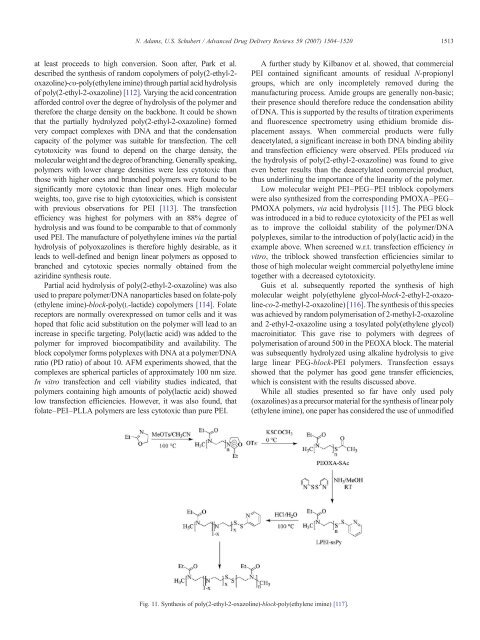Poly(2-oxazolines) in biological and biomedical application contexts
Poly(2-oxazolines) in biological and biomedical application contexts
Poly(2-oxazolines) in biological and biomedical application contexts
Create successful ePaper yourself
Turn your PDF publications into a flip-book with our unique Google optimized e-Paper software.
N. Adams, U.S. Schubert / Advanced Drug Delivery Reviews 59 (2007) 1504–1520<br />
1513<br />
at least proceeds to high conversion. Soon after, Park et al.<br />
described the synthesis of r<strong>and</strong>om copolymers of poly(2-ethyl-2-<br />
oxazol<strong>in</strong>e)-co-poly(ethylene im<strong>in</strong>e) through partial acid hydrolysis<br />
of poly(2-ethyl-2-oxazol<strong>in</strong>e) [112]. Vary<strong>in</strong>g the acid concentration<br />
afforded control over the degree of hydrolysis of the polymer <strong>and</strong><br />
therefore the charge density on the backbone. It could be shown<br />
that the partially hydrolyzed poly(2-ethyl-2-oxazol<strong>in</strong>e) formed<br />
very compact complexes with DNA <strong>and</strong> that the condensation<br />
capacity of the polymer was suitable for transfection. The cell<br />
cytotoxicity was found to depend on the charge density, the<br />
molecular weight <strong>and</strong> the degree of branch<strong>in</strong>g. Generally speak<strong>in</strong>g,<br />
polymers with lower charge densities were less cytotoxic than<br />
those with higher ones <strong>and</strong> branched polymers were found to be<br />
significantly more cytotoxic than l<strong>in</strong>ear ones. High molecular<br />
weights, too, gave rise to high cytotoxicities, which is consistent<br />
with previous observations for PEI [113]. The transfection<br />
efficiency was highest for polymers with an 88% degree of<br />
hydrolysis <strong>and</strong> was found to be comparable to that of commonly<br />
used PEI. The manufacture of polyethylene im<strong>in</strong>es via the partial<br />
hydrolysis of poly<strong>oxazol<strong>in</strong>es</strong> is therefore highly desirable, as it<br />
leads to well-def<strong>in</strong>ed <strong>and</strong> benign l<strong>in</strong>ear polymers as opposed to<br />
branched <strong>and</strong> cytotoxic species normally obta<strong>in</strong>ed from the<br />
azirid<strong>in</strong>e synthesis route.<br />
Partial acid hydrolysis of poly(2-ethyl-2-oxazol<strong>in</strong>e) was also<br />
used to prepare polymer/DNA nanoparticles based on folate-poly<br />
(ethylene im<strong>in</strong>e)-block-poly(L-lactide) copolymers [114]. Folate<br />
receptors are normally overexpressed on tumor cells <strong>and</strong> it was<br />
hoped that folic acid substitution on the polymer will lead to an<br />
<strong>in</strong>crease <strong>in</strong> specific target<strong>in</strong>g. <strong>Poly</strong>(lactic acid) was added to the<br />
polymer for improved biocompatibility <strong>and</strong> availability. The<br />
block copolymer forms polyplexes with DNA at a polymer/DNA<br />
ratio (PD ratio) of about 10. AFM experiments showed, that the<br />
complexes are spherical particles of approximately 100 nm size.<br />
In vitro transfection <strong>and</strong> cell viability studies <strong>in</strong>dicated, that<br />
polymers conta<strong>in</strong><strong>in</strong>g high amounts of poly(lactic acid) showed<br />
low transfection efficiencies. However, it was also found, that<br />
folate–PEI–PLLA polymers are less cytotoxic than pure PEI.<br />
A further study by Kilbanov et al. showed, that commercial<br />
PEI conta<strong>in</strong>ed significant amounts of residual N-propionyl<br />
groups, which are only <strong>in</strong>completely removed dur<strong>in</strong>g the<br />
manufactur<strong>in</strong>g process. Amide groups are generally non-basic;<br />
their presence should therefore reduce the condensation ability<br />
of DNA. This is supported by the results of titration experiments<br />
<strong>and</strong> fluorescence spectrometry us<strong>in</strong>g ethidium bromide displacement<br />
assays. When commercial products were fully<br />
deacetylated, a significant <strong>in</strong>crease <strong>in</strong> both DNA b<strong>in</strong>d<strong>in</strong>g ability<br />
<strong>and</strong> transfection efficiency were observed. PEIs produced via<br />
the hydrolysis of poly(2-ethyl-2-oxazol<strong>in</strong>e) was found to give<br />
even better results than the deacetylated commercial product,<br />
thus underl<strong>in</strong><strong>in</strong>g the importance of the l<strong>in</strong>earity of the polymer.<br />
Low molecular weight PEI–PEG–PEI triblock copolymers<br />
were also synthesized from the correspond<strong>in</strong>g PMOXA–PEG–<br />
PMOXA polymers, via acid hydrolysis [115]. The PEG block<br />
was <strong>in</strong>troduced <strong>in</strong> a bid to reduce cytotoxicity of the PEI as well<br />
as to improve the colloidal stability of the polymer/DNA<br />
polyplexes, similar to the <strong>in</strong>troduction of poly(lactic acid) <strong>in</strong> the<br />
example above. When screened w.r.t. transfection efficiency <strong>in</strong><br />
vitro, the triblock showed transfection efficiencies similar to<br />
those of high molecular weight commercial polyethylene im<strong>in</strong>e<br />
together with a decreased cytotoxicity.<br />
Guis et al. subsequently reported the synthesis of high<br />
molecular weight poly(ethylene glycol-block-2-ethyl-2-oxazol<strong>in</strong>e-co-2-methyl-2-oxazol<strong>in</strong>e)<br />
[116]. The synthesis of this species<br />
was achieved by r<strong>and</strong>om polymerisation of 2-methyl-2-oxazol<strong>in</strong>e<br />
<strong>and</strong> 2-ethyl-2-oxazol<strong>in</strong>e us<strong>in</strong>g a tosylated poly(ethylene glycol)<br />
macro<strong>in</strong>itiator. This gave rise to polymers with degrees of<br />
polymerisation of around 500 <strong>in</strong> the PEOXA block. The material<br />
was subsequently hydrolyzed us<strong>in</strong>g alkal<strong>in</strong>e hydrolysis to give<br />
large l<strong>in</strong>ear PEG-block-PEI polymers. Transfection essays<br />
showed that the polymer has good gene transfer efficiencies,<br />
which is consistent with the results discussed above.<br />
While all studies presented so far have only used poly<br />
(<strong>oxazol<strong>in</strong>es</strong>) as a precursor material for the synthesis of l<strong>in</strong>ear poly<br />
(ethylene im<strong>in</strong>e), one paper has considered the use of unmodified<br />
Fig. 11. Synthesis of poly(2-ethyl-2-oxazol<strong>in</strong>e)-block-poly(ethylene im<strong>in</strong>e) [117].
















